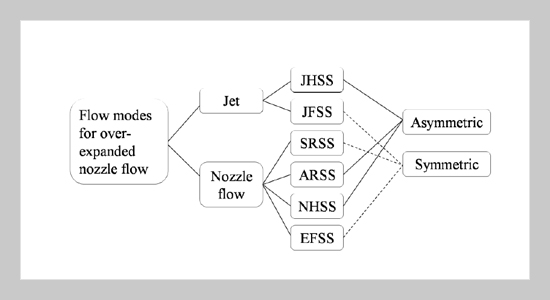REFERENCES
- [1] B. F. Carroll, J. C. Dutton, A Numerical and Experimental Investigation of Multiple Shock Wave/Turbulent Boundary Layer Interactions in a Rectangular Duct, Department of Mechanical and Industrial Engineering, Univ. of Illinois at Urbana-Champaign, Urbana, IL, Rept. UILU-ENG-88-4015 ,1988.
- [2] A. Hadjadj, M. Onofri, Nozzle flow separation, Shock Waves, 19 (2009) 163–169.
- [3] T. Gawehn, A. Gülhan, N. S. Al-Hasan, G. H. Schnerr, Experimental and numerical analysis of the structure of pseudo-shock systems in Laval nozzles with parallel side walls, Shock Waves, 20 (2010) 297–306.
- [4] D, Papamoschou, A. Zill, A. Johnson, Supersonic flow separation in planar nozzles, Shock Waves, 19 (2009) 171–183.
- [5] T. Ikui, K. Matsuo, M. Nagai, M. Honjo, Oscillation phenomena of pseudo-shock waves, Bulletin of the JSME, 17 (1974) 1278-1285.
- [6] B. F. Carroll, J. C. Dutton, Characteristics of multiple shock wave/turbulent boundary-layer interactions in rectangular ducts, Journal of Propulsion and Power, 6 (1990) 186-193.
- [7] L.Q. Sun, H. Sugiyama, K. Mizobata, R. Minato, A. Tojo, Numerical and experimental investigations on Mach 2 and 4 pseudo-shock wave in a square duct, Trans. Japan. Soc. Aero. Space Sci., 47 (2004) 124-130 .
- [8] H. Sugiyama, Y. Tsujiguchi, T. Honma, Structure and oscillation phenomena of pseudo-shock waves in a straight square duct at Mach 2 and 4, AIAA 2008-2646, 2008.
- [9] R.A. Lawrence, Symmetrical and unsymmetrical flow separation in supersonic nozzles, Research Report Number 67-1, Southern Methodist University ,1967.
- [10] D. Papamoschou, A. Zill, Fundamental investigation of supersonic nozzle flow separation, AIAA Paper 2004-1111, 2004.
- [11] E. Shimshi, G. Ben-Dor, A. Levy, A. Krot- hapalli, Experimental investigation of asymmetric and unsteady flow separation in high Mach number planar nozzles, Proceedings of the 28th International Symposium on Shock Waves, Manchester, 17 – 22 July, 2011.
- [12] A. Bourgoing, Ph. Reijasse, Experimental analysis of unsteady separated flows in a supersonic planar nozzle, Shock wave, 14 (2005) 251–258.
- [13] Q. Xiao, H.M. Tsai, D. Papamoschou, Numerical investigation of supersonic nozzle flow separation, AIAA J, .45 (2007) 532–541.
- [14] P. J. K. Bruce, H. Babinsky, B. Tartinville, C. Hirsch, Corner effect and asymmetry in transonic channel flows, AIAA J., 49 (2011) 2382-2392.
- [15] E. V. Myshenkov, E. V. Myshenkova, Hysteresis phenomena in a plane rotatable nozzle, Fluid Mechanics, 45 (2010) 667-678.
- [16] T-S Wang, Transient two-dimensional analysis of side load in liquid rocket engine nozzles, AIAA 2004-3680, 2004.
- [17] P.W. Carpenter, P.N. Green., The aeroacoustics and aerodynamics of high-speed Coanda devices, J. Sound & Vibration, .208 (1997) 777-801.
- [18] Takafumi Nishino, Seonghyeon Hahn, Karim Shariff., Large-eddy simulations of a turbulent Coanda jet on a circulation control airfoil, Phys. Fluids, 22 (2010) 125105.
- [19] C. Allery, S. Guerin, A. Hamdouni, A. Sakout, Experimental and numerical POD study of the Coanda effect used to reduce self-sustained tones, Mechanics Research Communications, 31 (2004) 105–120.
- [20] R. Neuendorf, I. Wygnanski, On a turbulent wall jet flowing over a circular cylinder, Journal of Fluid Mechanics, 381 (1999) 1–25.
- [21] B. G. Newman, The deflection of plane jets by adjacent boundaries–Coanda effect, Boundary Layer and Flow Control, edited by G. V. Lachmann, Vol. 1, Pergamon Press, Oxford, pp. 232–264 ,1961.
- [22] K.C. Cornelius, G.A. Lucius,, Physics of Coanda jet detachment at high-pressure ratio, J. AIRCRAFT, 31 (1994) 591-596.
- [23] S. Matsuo, T. Setoguchi, T. Kudo, Study on the characteristics of supersonic Coanda jet, J. of Thermal Science, 7 (1998) 165-175.
- [24] J. Ostlund and B. Muhammad-Klingmann, Supersonic flow separation with application to rocket engine nozzles, Applied Mechanics Reviews, 58 (2005) 143-177.
- [25] A. T. Nguyen, H. Deniau, S. Girard, T. Roquefort, Unsteadiness of flow separation and end-effects regime in a thrust-optimized contour rocket nozzle, Flow, Turbulence and Combustion, 71 (2003) 161–181.
- [26] Y. Koichi, M. Tsuyoshi, T.Yoshinobu, W. Yasuhide, Y. Kazuhiko, A Study of an asymmetric flow in an overexpanded rocket nozzle, Journal of Fluid Science and Technology, 2 (2007) 400-409.
- [27] A. Bourgoing, P.H. Reijasse, Experimental investigation of an unsteady and asymmetrical supersonic separated flow, 8th Aerodynamic Session Symposium, Toronto, 29 April–2 May 2001.
- [28] R. L. Simpson , Turbulent Boundary-Layer Separation, Ann. Rev. Fluid Mech. , 21(1989) 205-234.
- [29] M. Frey, G. Hagemann, Flow separation and side-loads in rocket nozzles, AIAA Paper 99-2815, 1999.
- [30] J. M. Davin, R. E. Petersen, An experimental investigation of unstable asymmetric jet separation in a supersonic converging -diverging nozzle, AIAA 1979-1256, 1979.
- [31] C.A. Hunter, Experimental, theoretical and computational investigation of separated nozzle flows, AIAA Paper 98-3107, 1998.
- [32] A. Nebbache, Ph. Reijasse, F. Bouvier, Symmetrical and asymmetrical separated nozzle flow, 6th International Symposium on Launchers Technologies, Munich, Germany, 8-11 November, 2005.
- [33] E. Martelli, F. Nasuti, M. Onofri, Numerical calculation of FSS/RSS transition in highly overexpanded rocket nozzle flows, Shock Waves, 20 (2010) 139–146.
- [34] T-S Wang, Transient three-dimensional startup side load analysis of a regeneratively cooled nozzle, Shock Waves, 19 (2009) 251–264.
- [35] D.S. Dolling, Fifty years of shock-wave /boundary-layer interaction research: what next? AIAA J., 39 (2001), 1517–1531.
- [36] S. Piponniau, J.P. Dussauge, J.F. Debieve, P. Dupont, A simple model for low-frequency unsteadiness in shock induced separation, J. Fluid Mech., 629 (2009) 87–108.
- [37] C-P Wang, C-F Zhuo. Model for Asymmetry of Shock/Boundary Layer Interactions in Nozzle Flows. Transactions of Nanjing University of Aeronautics and Astronautics, 2018, 35(1):146-153.
- [38] S. B. Verma, C. Manisankar. Origin of flow asymmetry in planar nozzles with separation. Shock Waves (2014) 24:191–209.
















